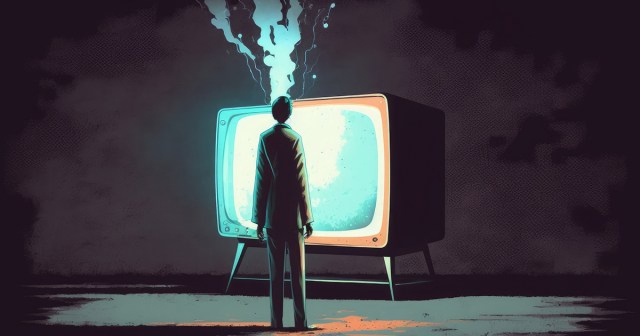
Everyone understands that the industry is in a period of excessive disruption, but few present the developments over the next decade with the apprehension as the analysts at Rethink Research.
Let’s look at their reasoning and compare it to our realities.
“2033 is a cliff, over which the media and entertainment industry will barrel,” its report, “The Crash of 2033,” states. (You can download the full analysis here).
Here’s the thinking:
“Declining pay-TV operators will not have the market power to secure exclusive content rights. Sports will be lost to OTT video rivals, and at this point, the roof will cave in — prompting the abandonment of legacy video distribution networks, and the collapse of many major operators that cannot extricate themselves from these car crashes.”
Even if, as is inevitable, pay-TV operators shift all of their services to IP-based delivery, it is too little too late, according to Rethink’s analysis.
Counterpoint: Why TV and Streaming Are Going to Need Disruption: A Holistic View of the Video Value Chain
The analysts predict: “This will lump their video services in with their rivals, and without the ability to use consumer premises equipment to assert a user experience, most will be lost in the wash.”
The Rethink research team settled on 2033 as significant because it marks the end of many current long-term sports rights contracts, which (as of this moment) remain in the hands of studios, networks and pay-TV operators.
But beyond this, legacy TV will not have the financial muscle to compete.
“For traditional pay-TV operators and broadcasters, sports and news are the last two bastions — all that is left between the high-margin halcyon days and total irrelevance.”
Counterpoint: Accenture: Traditional Media Needs To Think Very Differently

You Need to Calm Down
Taylor Swift’s “Eras” tour and cinema concert film offers some life for traditional media, Rethink suggests, by illustrating “plenty of scope for using movie theaters to show content other than movies.”
eSports, however, is projected as a dead end: “It has continually disappointed as a salvation for Hollywood. This could change, but is not a safe bet, despite younger consumers playing more games and spending more time watching streamers.”
Counterpoint: How Broadcasters Could/Should Optimize Their Infrastructure for eSports
Younger generations brought up consuming media on mobile devices, coupled with advances to mobile connectivity (5G) will deliver a decisive blow to the old fixed-infrastructure ecosystem of broadband cable and satellite.
“The first consumers that will never take a fixed-line offering have already been born, and so the expansion into cellular will become existential for those with fixed-line offerings,” the paper states.
ATSC 3.0 (the hybrid broadcast/streaming delivery mechanism) “has come too late to prevent the onslaught of cord cutting in the US.”
The Cost of AI for Hollywood
Rethink also has some strong statements about AI, including a prediction that 2026 is the year the waters will break.
That’s when the agreements signed with the WGA in Q4 2023 will end. The current contract stipulates that script writers themselves are allowed to lean on generative AI systems such as ChatGPT in the creative writing process, and then sell these scripts to studios.
“This is a canny move from the Hollywood studios,” the analysts say. “Advancements in GenAI between now and May 2026 will be lethally swift and effective, by which time script writers will be so adept in generative AI taking away the mundane tasks, that many content writers will not have a leg to stand on when the next bout of strikes come around.”
Further, “once AI has mastered a single production, the technology will be tasked with spinning up entire catalogs of content and even linear TV channels — with FAST positioned as a perfect partner.
“As a result, the next decade will be rife with litigation, and these fierce court battles will further deplete Hollywood studios to the point of destitution.”
Counterpoint: Guess Who Decides the Role of AI in Hollywood? Oh Yeah, You, a Human

So… Just a Mid-Level Panic?
There’s a lot of panic in Rethink’s analysis but it remains that some of the messaging is insightful.
That M&E should have its eyes on 2026 is important to underline. GenAI will have advanced to a considerable degree by then. We will probably be on Sora 3.0 and the end of agreements with writers and actors will force Hollywood’s hand to engage with AI on a less cautious level.
As to whether the whole industry as we know it has already pressed the self-destruct button in failure to shift to streaming models and widen business portfolios sufficiently beyond film and TV, well… this does sound more than a little alarmist.
There will be change, but it will be evolutionary… nothing is going to drop off a cliff. There are a lot of people in our industry who are too smart to allow that.

Why subscribe to The Angle?
Exclusive Insights: Get editorial roundups of the cutting-edge content that matters most.
Behind-the-Scenes Access: Peek behind the curtain with in-depth Q&As featuring industry experts and thought leaders.
Unparalleled Access: NAB Amplify is your digital hub for technology, trends, and insights unavailable anywhere else.
Join a community of professionals who are as passionate about the future of film, television, and digital storytelling as you are. Subscribe to The Angle today!


